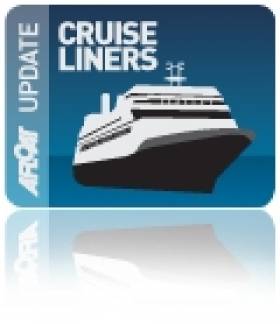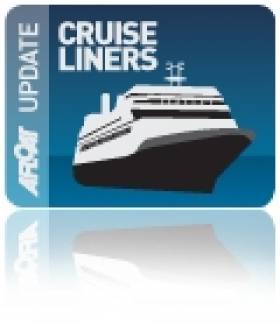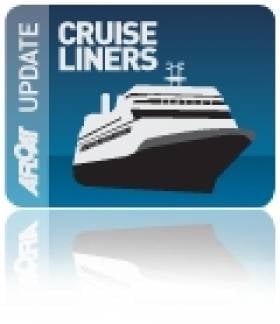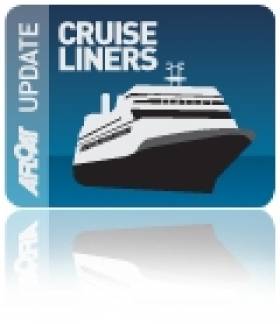Displaying items by tag: Cunard Line
Cunard Head to Holyhead, Anglesey this Summer as Cruise Tourism Becomes 'Big Business' in Wales
Cruisecalls among them from Cunard Line is to visit the Port of Holyhead, Anglesey this summer as the tourism sector booms in Wales.
This year the country is due to welcome a record 91 cruiseships to date, with Holyhead port leading the way with more than half of the total calling to the port.
Across the Irish Sea, as Afloat reported Dun Laoghaire Harbour (alone is to pip the Welsh national total) with 92 cruise visits booked this season so far to visit the Irish harbour, though no 'Cunarders' are scheduled to call this year.
Holyhead, however will have the prestigious MS Queen Victoria which is scheduled to dock on 4 June, its first call at the deep water jetty (acquired, see story) under Stena Line’s ownership. The Vista class 16-deck ship, is likened to a sea liner because of its interior decor, and the Italian built cruiseship (a sister of Queen Elizabeth), is capable of carrying almost 2,100 passengers as well as 900 crew.
The “cruise is big business in Wales” and this is where the Welsh Government has been working with Cruise Wales – a partnership between the country’s six cruise ports. Asides Holyhead, Afloat adds all these ports are all in south Wales, they are Fishguard, Pembroke Dock (Milford Haven), Swansea, Cardiff and Newport.
To promote the sector, Cruise Wales is develop new onshore tour itineraries for passengers and also to showcase the nation’s attractions. Examples of these new breed of itineraries include the themes of ‘Coal, Coin and Cheers’ with tours throughout south Wales.
In total this year Wales is to see 80,000 passengers and 39,000 crew, this equates to a potential passenger day spend income of £8.3 million.
The first call of the 2023 season to Holyhead will be Viking Venus on 6 April and on the same day Spitzbergen is scheduled to visit Fishguard.
Holyhead is to welcome more than half the nation’s total with 53 calls.
The call by Viking Venus is to take place following a visit to Dun Laoghaire Harbour which opens the season for the Irish port and this will involve an anchorage call.
More from NorthWalesLive here.
#CruiseLiners - Donegal received its biggest ship ever in Killybegs yesterday, Friday 20 July.
As Donegal Now reported the 'Queen Elizabeth' has over 2,000 passengers and a crew of more than 1,000.
The luxury ship, part of the Cunard Line, is on a cruise around the British and Irish coasts.
The deep water berth at Killybegs means huge cruise liners can call to the port.
Killybegs is now increasingly appearing on the cruise map of Europe.
The ship turned around just off the coast and reversed into Killybegs harbour.
The cruiseliner Afloat adds departed to Greenock, Scotland and will continue on its cruise back to Southampton from where it left last week.
Two Cunarder "Queens" to Visit Donegal
#CunardDonegal - Two of the most famous names in British royalty are coming to Donegal - but it’s not members of the royal family; rather, it’s two massive 'Vista' class cruise ships named “Queen Elizabeth” and “Queen Victoria”!
The famous Cunard Line writes Donegal Now, has confirmed that two of its prestige 90,000 gross tonnage cruiseships will visit Killybegs in 2018 as part of two new cruise itineraries.
Both vessels are almost 300 metres long – more than twice the length of Croke Park!
The announcement is yet further evidence that Killybegs is now really making a name for itself as a cruise ship port of call.
“This is a good news story for Killybegs and for Donegal,” commented Anne Dorrian of the Killybegs Tourism Information Centre.
The tourism spin-off is considerable, with many of the passengers going on local tours and taking in attractions such as Slieve League and Glenveagh National Park as well as visiting the likes of Donegal Town.
Meanwhile, the Fred Olsen line has become the first cruise line to enable passengers to embark in Killybegs. In September passengers will be able to go on board the "Boudicca" on the "Rugged and Rural Canada" cruise to Newfoundland, Canada and back.
For details of the cruise and more, Donegal Now has a report here.
Another ‘Cunarder’ Call is to Bring 'Elizabeth'
#CunarderCALL – Cunard Line's newest cruiseship, the 90,901 tonnes Queen Elizabeth is to make her maiden call off Dun Laoghaire Harbour tomorrow. She is the second largest ship built for the company after Queen Mary 2 which called earlier this summer, writes Jehan Ashmore.
Queen Elizabeth has 12 passenger decks accommodating 2,068 guests and the 294m vessel first paid a visit to Dublin Bay with a call to Dublin Port in 2011, the same year of her namesake's historic state visit by Queen Elizabeth. A subsequent return call by the cruiseship as previously reported was made this time last year.
Captain C. Wells has command of the 2010 built ship which is currently docked alongside Liverpool Cruise Terminal and is due to arrive in Dublin Bay around 07.30hrs tomorrow morning.
Her visit to Dun Laoghaire is part of a British Isles 12-Day Cruise which set off from Hamburg late last month and terminates in Southampton following an en route call to St. Peter Port, Guernsey.
Cunard Line's third ship, Queen Victoria is a sister and they both are of the same design to P&O Cruises Arcadia which called offshore to Dun Laoghaire almost a month ago. There are external differences particularly along the uppermost decks.
Both companies are subsidiaries of the world's largest cruise shipping group, Carnival Corporation which too operates Holland America Line (HAL) whose medium-sized cruiseship, Eurodam recently visted Dublin Port and as previously reported off Dunmore East.
Eurodam also shares this same Italian built cruiseship design, from the Fincantieri shipyard in Marghera, Venice, albeit the most notable difference is the twin funnel stacks.
Additonal information from Dun Laoghaire Harbour Company:
The prestigious Queen Elizabeth cruise liner will dock in Dún Laoghaire Harbour tomorrow, Wednesday, 7th August 2013, from 7am to 6pm.
The ship belongs to the world-famous Cunard Line and is decorated in an art deco style reminiscent of 1930s ocean liners. Dún Laoghaire will be the fifth port of call for the Queen Elizabeth since it set sail from Southampton a week ago on a 10-day cruise of Britain and Ireland.
Speaking ahead of the arrival, CEO of Dún Laoghaire Harbour Company, Gerry Dunne, said: "The iconic Queen Mary 2 visited Dún Laoghaire in May and today we are delighted to welcome her sister ship, the Queen Elizabeth. It is a tremendous boost for the harbour to have a visit from a ship of her calibre."
Ports & Shipping Review: ‘Signature’ Cruiseship, Fishery Detentions, ‘Royal’ Cruiseship, Belfast’s Battleship, Port of Cork Wins Award
#PORTS & SHIPPING REVIEW - Over the last fortnight Jehan Ashmore has reported from the Shipping scene which saw 'signature' cruiseship Mein Schiff 2 with her striking visual livery-scheme calling to Irish ports.
The Naval Service has been made detentions of Irish registered fishing vessels this week and also last month off the Clare and Cork coastlines, bringing to date 12 such incidents so far this year.
The world's smallest 5-star luxury cruiseship Hebridean Princess (1964/2,112grt) which was chartered twice in recent years for the Royal Family, called to Dublin Port recently and is currently on a return cruise from Cork with anchorage calls in Kerry waters.
Dublin Based d'Amico have ordered a pair of 40,000dwt eco-product/chemical tanker vessels, believed to cost US$ 30.65 million, from a South Korean shipyard and delivered early in 2014.
Since her launch in 2010, Cunard Line's newest cruiseship Queen Elizabeth (90,901 tonnes) made her second only visit to Dublin Port, where she called last year and also to Cork, which too was revisited by the 2068 passenger vessel.
The on-going saga to retain the veteran WWI Battle of Jutland survivor HMS Caroline in Belfast, her homeport since 1924 was given a reprieve. The National Museum of the Royal Navy (NMRN) in Portsmouth secured a four-week extension to the original deadline (1 Aug) which was set for scrapping of the historic warship.
The near fifty year-old Hebble Sand (1963/757grt), a grab-hopper dredger which has remained in Dublin Port for more than one year departed Dublin Port and reached Campbeltown last week for new Northern Irish owners Abco Marine.
Port of Cork Company was awarded 'Large Company of the Year for the 2nd Quarter 2012' by the Cork Business Association. This season the port is to welcome 60 cruiseships between April and November, bringing more than 100,000 passengers and crew to the region.
While in Dublin Port, Finnish based Kristina Cruises 400 passenger Kristina Katarena made her inaugural Irish call, the 1982 built vessel was launched from New Szczecin Shipyard. The name of the Polish city may sound familiar as they are the presenting sponsor of Tall Ships Races which are coming to the capital later this month.
Cunard Line's Newest Cruiseship to Revisit
#CUNARDER REVISIT – Since her launch in 2010, Cunard Line's newest cruiseship the 90,901 tonnes Queen Elizabeth has only called to Dublin Port once and that was last year. She was then on her maiden 'Irish' port of call and the 2068 passenger vessel is to return on Saturday, writes Jehan Ashmore.

Joining her on the schedule of visiting cruiseships this August, which not surprisingly is the busiest period of the high-season, will be Holland America Line's Maasdam. She is to arrive only an hour later that morning.
The month is scheduled to see 28 cruise callers (list) in total, the first caller having already arrived yesterday with the Hebridean Princess staying overnight in the port.
Following the Cunarder's call she will her head overnight bound for Cobh Cruise Terminal, where the Italian built vessel also made an inaugural port of call (list) in 2011.
Double Role Recalled as Cruiseship Sails South
#CRUISELINERS – Cruise & Maritime Voyages Ocean Countess (17,593 tonnes) departed Liverpool's City Cruise Terminal this evening bound for Cobh, though thirty years ago she sailed considerably further south and for completely different reasons, writes Jehan Ashmore.
The 800 passenger capacity was built in 1976 for Cunard Line as their Cunard Countess which undertook an unusual charter less than a decade later. For six months she was used as a troopship by the British Government's Ministry of Defence after the conclusion of the Falklands War in 1982.
The vessel's deployment was to support troop movements between Ascension Island and Port Stanley whilst the islands airfield at Port Stanley was being reinstated.
She sailed 8,000 miles to the South Atlantic islands, where families and friends of British personnel lost in the conflict were also carried on one round voyage. This was to enable commemorations to take place at sea and ashore. Today marks the end of the war, where further commemorations were held on the islands and in the UK.
Cruise Callers to Dun Laoghaire ‘Recalled’
#DUN LAOGHAIRE CRUISELINERS – The recent call of what is believed to be the world's smallest cruiseship the Quest (1991/1,180grt) to Dun Laoghaire Harbour as part of an initiative to develop this sector is by no means completely new to the harbour, writes Jehan Ashmore.
It was not until a decade ago that the last cruise callers were on the scene, albeit making infrequent visits and they also varied considerably in size. Among the callers was the famous 'Cunarder' Queen Elizabeth 2 or 'QE2', RCCL's Norway formerly French Line's France and Celebrity Cruise then brand new Constellation. Notably these large vessels all made anchorage calls in Dublin Bay.
Constellation made this call in 2002 as did the Sun Bay II which was also then recently launched into service and the cruiseships were making their debut season in European waters. They could not be so different, the 2,800 tonnes Sun Bay II with an 89 passenger capacity in complete contrast to the 90,000 tonnes Constellation with over 1,800 passengers.
The diminutive Sun Bay II was not too dissimilar to Noble Caledonia's Quest in terms of passenger capacity being slightly smaller with a capacity of 52. She was alongside Carlisle Pier where her guests were on a 9-night Garden themed cruise of UK and Ireland that included tours to Powerscourt and Mount Usher in Co. Wicklow.
On the call of Constellation she anchored relatively closer to the shore off Bulloch Harbour, compared to QE2 and Norway's calls and she presented an imposing and impressive sight.
In the case of the Norway, her passengers were ferried to the marina by unusually large tenders more akin to tank landing craft as they bow doors (click PHOTO). In fact they were so large that they could not be stowed on the lifeboat deck and instead located forward of the bridge where deck-mounted cranes were used for hoisting operations.
The practice of anchorage calls will continue as vessels of this size will remain too large to be accommodated in the harbour in the short term, though the Dun Laoghaire Harbour Company's 'masterplan' includes a proposed €18m new cruise terminal. They claim the terminal would be capable of handling the largest and most modern cruiseships in the world.
In the meantime the landing point for tenders to use a new tender dock facility was installed recently at the Traders Wharf, as distinct to the Carlisle Pier (site of proposed Diaspora Museum) where small to medium sized vessels are to berth.
A further three more calls are scheduled this season, including a return call next week of Quest and other vessels capable of carrying around 500 passengers. This figure is to rise considerably in May 2013, thanks mostly due in part to the massive Cunard Line flagship Queen Mary 2 (QM2). The 151,400 tonnes 'liner' can take over 2,600 passengers and 1,200 crew alone.
With the visit of QM2, this is to be her fist call to Dublin Bay, as she is still to be big even for Dublin Port to handle. Likewise the rivals across Dublin Bay in the Dublin Port Company are proposing as part of their masterplan to build a €30m dedicated cruise terminal. This facility would also be able to accommodate very large cruise callers.
It will be interesting to see how both completing ports progress and how they market themselves to the cruise sector industry, no doubt across the board. The giant ships look after large volumes which keep cruise prices down. As for the smaller boutique style of cruiseship operators, they can command higher prices by targeting the top end of the market and where they have higher-spending power at ports of call . The cruise industry overall is becoming increasingly more globalised where it was traditionally the preserve of the European and North American markets.
Arguably it is debatable if there should be two cruise terminals built as it reminiscent of the controversary during the '80's over the battle between which Dublin Bay port would be chosen for the site of a new single dedicated multi-user car-ferry terminal.
As it transpired the ferry service to Holyhead remains operating out of Dun Laoghaire Harbour, where a new terminal was built specifically to dock the revolutionary design of the HSS (High-speed Sea Service) fast craft catamaran car-ferry. Albeit in recent years the route's sailing frequency has reduced considerably. Under the last contract between Stena and the harbour company, this has led to considerably less revenue generated in harbour dues. The HSS Stena Explorer currently maintains only a single daily round-trip and only on a seasonal basis between April-September.
While at Dublin Port a multi-user ferry terminal was built but Stena Line did not immediately become part of the facility. It was not until 1995 that they set up an additional new service from Dublin Port to Holyhead. They use a second adjacent terminal that is currently served by two ferries on the company's second route to Wales.
#CRUISELINERS – The Quest (1992/1,180grt) an ice-strengthened expedition cruiseship, will have the distinction of being the first cruise caller to Dun Laoghaire Harbour in many years. The cruise call next week (24th April) will mark a new era in attracting the cruise sector as part of the harbour's masterplan launched last year, writes Jehan Ashmore.
The Quest will have a German clientele of around 50 passengers, though other larger capacity vessels are scheduled for the summer in this first phase of cruise callers. The cruise sector season is seen to be a significant economic boost to the local economy considering the reduced ferry side of the harbour business in recent years.
Passengers on the Noble Caledonia operated vessel are to take a 9-night 'Garden' Cruise with prices starting from £3,295. She is to set sail from Oban Scotland, then to Ireland, Wales, Cornwall, the Isles of Scilly and Channel Islands.
On her Dun Laoghaire call passengers will head for Powerscourt and nearby Mount Usher gardens in Co. Wicklow. On the second Irish port of call to Waterford as previously reported, they will visit the privately owned Mount Congreve Gardens on the banks of the River Suir.
Notably scheduled in for next year's season is the 'flagship' of the Cunard Line fleet, the 2,620 passenger liner Queen Mary 2, all of 151,400 gross tonnes. She is to make an anchorage call in May 2013, according to Captain Frank Allan, Dun Laoghaire Harbourmaster.
As part of the programme to attract and develop Dun Laoghaire as a cruise call port of call, a new tender docking facility was recently completed. The facility is designed to cater for large cruiseships using the harbour as it will cater for easier access by boats tendering passengers to vessels such as Queen Mary 2 during anchorage calls out in Dublin Bay.
The new tender facility will also benefit the public as the facility can be used for training purposes and for the operation of boat tours around Dublin Bay and trips out to Dalkey Island.
- Dun Laoghaire Harbour
- Cruise Liners
- Irish cruise calls
- Noble Caledonia
- MVQuest
- Cunard Line
- Queen Mary 2
- QM2
- Dun Laoghaire Harbour Company
- Dublin Bay
- Dublin Bay anchorage cruise calls
- Dalkey Island
- Powerscourt Gardens
- Mount Congreve Gardens Waterford
- River Suir
- Dun Laoghaire Harbour Masterplan
- Dublin Bay News
Cork Cruise Caller Line-Up for 2012
#CRUISE LINERS – The Port of Cork is to welcome 60 cruise vessels this season, an increase on 2011 levels when 53 calls were made, bringing over 100,000 passengers and crew to the region, writes Jehan Ashmore.
According to UK Consultants GP Wild, the average in-transit spend per passenger, while visiting an Irish port is between €73- €100 which provides a significant contribution towards the local tourism economy.
Last year Cork won 1st place for 'Best Destination Experience (Organised)' in the world and 2nd place for 'Best Port Welcome' in the Dream World Cruise Destinations Awards.
Fred Olsen Cruise Lines Balmoral is the first caller for 2012 when she is to dock at Cobh in April. Larger cruise ships to visit during the season include Celebrity Eclipse, Emerald Princess, Independence of the Seas, Costa Deliziosa and Caribbean Princess.
In addition Cunard Line's Queen Elizabeth is to return to Cobh in August. Her inaugural Irish visit was in September last year, when the 90,000 tonnes vessel called firstly to Dublin followed by Cobh, to read more click HERE.
For a list of the cruise schedule, click HERE, noting several calls are to Ringaskiddy and North Custom House Quay in Cork City.




































































